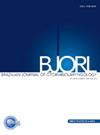通过批量多组学测序和单细胞测序建立与 TP53 基因突变相关的下咽鳞状细胞癌预后模型
IF 1.7
4区 医学
Q2 OTORHINOLARYNGOLOGY
引用次数: 0
摘要
方法从TCGA数据库下载TP53突变和转录组数据。从 GEO 数据库下载了 GSE65858、GSE41613、GSE3292、GSE31056、GSE39366 和 GSE227156 数据集的基因表达数据。采用GSEA、单变量、多变量Cox分析和LASSO分析来确定关键基因并构建预后模型。利用ROC曲线验证模型得出的OS和RFS结果。通过ggplot2、corrplot软件包和GSVA分别分析了风险评分与各种临床病理特征和免疫评分之间的关联。通过无偏聚类和SingleR细胞注释分析了单细胞测序数据。结果最初确定了两个关键基因POLD2和POLR2G,并利用这两个基因构建了预后模型。根据模型得出的风险评分,样本被分为不同的风险组,高风险组样本的预后较差。此外,风险评分与患者的淋巴转移以及 CD4+ T、CD8+ T、树突状细胞、巨噬细胞和中性粒细胞的免疫评分呈正相关。高危组和低危组之间的免疫反应也存在明显差异。单细胞测序分析结果表明,上皮细胞和巨噬细胞在 HPSCC 样本中相对较多。结论该预后模型可根据 TP53 突变情况预测 HSPCC 样本的预后,并可通过模型获得的不同风险评分预测样本的癌症特征和免疫浸润评分。本文章由计算机程序翻译,如有差异,请以英文原文为准。
Development of the TP53 mutation associated hypopharyngeal squamous cell carcinoma prognostic model through bulk multi-omics sequencing and single-cell sequencing
Objective
The aim of this study was to construct a prognostic model based on the TP53 mutation to calculate prognostic risk scores of patients with HPSCC.
Methods
TP53 mutation and transcriptome data were downloaded from the TCGA databases. Gene expression data from GSE65858, GSE41613, GSE3292, GSE31056, GSE39366, and GSE227156 datasets were downloaded from the GEO database. GSEA, univariate, multivariate Cox analyses, and LASSO analysis were employed to identify key genes and construct the prognostic model. ROC curves were utilized to validate the OS and RFS results obtained from the model. The associations between risk scores with various clinicopathological characteristics and immune scores were analyzed via ggplot2, corrplot package, and GSVA, respectively. Single-cell sequencing data was analyzed via unbiased clustering and SingleR cell annotations.
Results
Initially, two key genes, POLD2 and POLR2G, were identified and utilized to construct the prognostic model. Samples were divided into different risk groups via the risk scores obtained from the model, with high-risk group samples exhibiting poorer prognosis. Furthermore, the risk score exhibited a positive correlation with lymphatic metastasis in patients and the immune scores of CD4+ T, CD8+ T, dendritic cell, macrophage, and neutrophil. The immune responses also exhibited notable disparities between the high- and low-risk groups. The results of single-cell sequencing analysis demonstrated that epithelial cells and macrophages were relatively abundant in HPSCC samples. POLD2 and POLR2G exhibited higher expressions in epithelial cells, with most of the identified pathways also enriched in epithelial cells.
Conclusion
The prognostic model exhibited a significant capacity for predicting the prognosis of HSPCC samples based on the TP53 mutation conditions and may also predict the cancer characteristics and immune infiltration scores of samples via different risk scores obtained from the model.
Level of evidence
Level 5.
求助全文
通过发布文献求助,成功后即可免费获取论文全文。
去求助
来源期刊

Brazilian Journal of Otorhinolaryngology
OTORHINOLARYNGOLOGY-
CiteScore
3.00
自引率
0.00%
发文量
205
审稿时长
4-8 weeks
期刊介绍:
Brazilian Journal of Otorhinolaryngology publishes original contributions in otolaryngology and the associated areas (cranio-maxillo-facial surgery and phoniatrics). The aim of this journal is the national and international divulgation of the scientific production interesting to the otolaryngology, as well as the discussion, in editorials, of subjects of scientific, academic and professional relevance.
The Brazilian Journal of Otorhinolaryngology is born from the Revista Brasileira de Otorrinolaringologia, of which it is the English version, created and indexed by MEDLINE in 2005. It is the official scientific publication of the Brazilian Association of Otolaryngology and Cervicofacial Surgery. Its abbreviated title is Braz J Otorhinolaryngol., which should be used in bibliographies, footnotes and bibliographical references and strips.
 求助内容:
求助内容: 应助结果提醒方式:
应助结果提醒方式:


